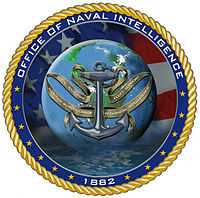Office of Naval Intelligence

The Office of Naval Intelligence (ONI) was established in the United States Navy in 1882. ONI was established to "seek out and report" on the advancements in other nations' navies. The oldest member of the United States Intelligence Community, ONI is headquartered at the National Maritime Intelligence Center in Suitland, Maryland.
History
ONI was founded by the Secretary of the Navy, William H. Hunt with General Order 292, dated March 23, 1882, which read:
An "Office of Intelligence" is hereby established in the Bureau of Navigation for the purpose of collecting and recording such naval information as may be useful to the Department in time of war, as well as in peace.To facilitate this work, the Department Library will be combined with the "Office of Intelligence," and placed under the direction of the Chief of the Bureau of Navigation.
Commanding and all other officers are directed to avail themselves of all opportunities which may arise to collect and to forward to the "Office of Intelligence" professional matters likely to serve the object in view.[1]
ONI's position as the naval intelligence arm began in earnest when the United States declared war on Spain in 1898 in response to the sinking of the U.S. battleship Maine in the harbor of Spanish-controlled Havana, Cuba. ONI's powers grew as it became responsible for the "protection of Navy Personnel, censorship and the ferreting out of spies and saboteurs."
In 1929, the Chief of Naval Operations made these functions the permanent duties of ONI. As Japan's military endeavors in Russia and China in the 1930s proved increasingly successful, the ONI began conducting domestic surveillance on Japanese Americans in Hawaii and the West Coast. By 1939, Naval Intelligence was working with the FBI and the Military Intelligence Division to monitor potential fifth column activity among Japanese immigrants and, to a lesser degree, their American-born children.[2] In 1941, Kenneth Ringle, assistant district intelligence officer for the Eleventh District in Los Angeles, was commissioned to conduct a thorough investigation on the "Japanese problem"; he found little evidence of Japanese American saboteurs and advised against mass incarceration in his final report to President Roosevelt. Ringle's views on Japanese American loyalty were shared by most ONI officials but were largely ignored by the Army and War Department commanders who pushed for the internment.[3] During World War II, Naval Intelligence became responsible for the translation, evaluation and dissemination of intercepted Japanese communications, in addition to counter-intelligence directed at Japanese Americans in and out of camp[2]—and its budget and staff grew significantly. While other parts of the Navy were downsized after the war, Fleet Admiral Nimitz ensured ONI's continued strength, which was to prove important during the Cold War.
Organization
Nimitz Operational Intelligence Center
The Nimitz Center has responsibility for Maritime Domain Awareness (MDA) and Global Maritime Intelligence Integration (GMII).
Kennedy Irregular Warfare Center
Commanded by a captain, the Kennedy Center provides support to Navy Special Warfare and Navy Expeditionary Combat Command forces
Hopper Information Services Center
The Hopper Center provides information services that support global maritime and intelligence operations.[4]
Notable Naval Intelligence Officers
- George P. Bush, Nephew of George W. Bush
- Eric Garcetti, Mayor of Los Angeles, California
- Bobby Ray Inman, ADM USN, Director of Naval Intelligence (1974-76), Director National Security Agency (1977-81)
- Mark Kirk, United States Senator from Illinois
- Edwin T. Layton, American cryptanalyst during World War II
- Mark Lippert, Chief of Staff for the United States Secretary of Defense and U.S. Ambassador to South Korea.
- Joseph Rochefort, American cryptanalyst during World War II
- John Paul Stevens, Associate Justice of the United States Supreme Court
- William O. Studeman, ADM USN, Director of Naval Intelligence (1985-88), Director National Security Agency (1988-92, Deputy Director of Central Intelligence (1992-95)
- Byron White, Associate Justice of the United States Supreme Court
- Bob Woodward, Investigative Reporter at The Washington Post
See also
- Directors of the Office of Naval Intelligence
Notes
- ↑ General Order No. 292. History.navy.mil (2012-08-22). Retrieved on 2013-08-16.
- ↑ 2.0 2.1 Niiya, Brian. "Office of Naval Intelligence". Densho Encyclopedia. Retrieved 2014-09-22.
- ↑ Niiya, Brian. "Kenneth Ringle". Densho Encyclopedia. Retrieved 2014-09-22.
- ↑ http://www.oni.navy.mil/commands/Hopper.html. Retrieved 10 February 2015. Missing or empty
|title=(help)
References
- Packard, Wyman H. (1996). Century of U.S. Naval Intelligence. Naval Historical Center. ISBN 0-945274-25-4.
- Portions of this article are based on public domain text from Office of Naval Intelligence.
- Portions of this article are based on public domain text from Digital National Security Archive.
External links
- Office of Naval Intelligence
- FOIA files on the ONI, hosted at the Internet Archive:
| |||||||||||||||||||||||||||||||||||||||||||||||

